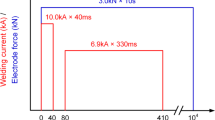Abstract
Resistance spot welding of advanced high strength dual phase steel, with tensile strength of 980 MPa at elongation of 10 %, was experimentally investigated and numerically simulated. The FEM simulation was performed using SYSWELD in order to calculate the thermal and residual stress fields for research of effect of RSW fracture behavior. Thermo-mechanical properties of the material were modified from DP600 data to experimentally determined DP1000 from hot tensile tests made with a Gleeble system. The predefined G-electrode shape was changed to the F16-electrode used in practice. Effect of welding current on nugget size and residual stresses is examined for lower, medium, and upper currents inside welding range. Simulation nugget and heat-affected zone of the 2D model show a correlation if compared to experimental results from metallography of RSW cross sections. Residual stresses are measured using the drill hole method, but they differed from simulated stresses. Possible reasons are evaluated and discussed.










Similar content being viewed by others
References
Pouranvari M, Marashi SPH (2011) Failure mode transition in AHSS resistance spot welds. Part 1. Controlling factors. Mater Sci Eng A 528:8337–8343
Iyota M, Mikami Y, Hashimoto T, Taniguchi K, Ikeda R, Mochizuki M (2013) The effect of martensitic transformation on residual stress in resistance spot welded high-strength steel sheets. J Alloys Compd 577(1):684–689
EN ISO 14329 (2003) Resistance welding destructive tests of welds failure types and geometric measurements for resistance spot seam and projection welds, Geneva, Switzerland: International Organization for Standardization
Ernst W, Galler M, Vallant R, Enzinger N (2009) “Modification of coupling parameters for a more accurate numerically coupled” in Sysweld Forum, Dorint Am Goeathepark, Weimar, Germany
Kičin M, Diploma thesis. Experimentelle Ermittlung thermisch-mechanischer Eigenschaften von verzinktem DP1000 Stahl als Input Dateien fur die Simulation des Widerstandspunktschweissens, Austria, Graz: Technical University of Graz, 4/2011
Pouranvari M, Marashi SPH (2011) Failure mode transition in AHSS resistance spot welds. Part 2: experimental investigation and model validation. Mater Sci Eng A 528:8344–8352
Khan MI, Kuntz ML, Biro E, Zhou Y (2008) Microstructure and mechanical properties of resistance spot welded advanced high strength steels. Material Trans 49(7):1629–1637
(2004) “Know-how in Kupferwerkstoffen: Fertigteilkatalog” Thyssen Duro Metall, Kornwestheim, Germany
Rendler NJ, Vigness I (1966) Hole-drilling strain-gage method of measuring residual stresses. Exp Mechnanics 6(12):577–586
EN ISO 14271 (2011) Resistance welding—Vickers hardness testing (low-force and microhardness) of resistance spot, projection, and seam welds, Geneva, Switzerland: International Organization for Standardization
(2008) User’s guides for SYSWELD spot welding simulation, Paris: ESI Group
Eshraghi M, Tschopp MA, Zaeem MA, Felicelli SD (2014) Effect of resistance spot welding parameters on weld pool properties in a DP600 dual-phase steel: a parametric study using thermomechanically-coupled finite element analysis. Mater Des 56:387–397
Srikunwong W (2005) Modelisation du procedure de soudage par points. Mines Paris Tech, Paris
Anderson O (2013) Process planning of resistance spot welding. KTH, Stockholm
(2014) Reference Manual, Paris: ESI Group
Leblond J (1986) A theoretical and numerical approach to the plastic behaviour of steels during phase transformations, I. Derivation of general relations. J Mechanics and Physics of Solids 34(4):395–409
Leblond J (1986) A theoretical and numerical approach to the plastic behaviour of steels during phase transformations, II. Study of classical plasticity for ideal-plastic phases. J Mechanics and Physics of Solids 34(4):411–432
Robin V, Bernauer G, Akguen T, Heubrandtner T (2005) “Spotweld performence under high strain rate loading conditions,” in mathematical modelling of weld phenomena, vol 7. Technical University of Graz, Graz, pp 419–434
Acknowledgments
The authors would like to thank the financial support of k-net JOIN, network of excellence for joining under the Federal Ministry of Economy and Labor, Austria. Also thank you to voestalpine Stahl GmbH, Linz, for providing material, and assistance for the welding experiments and metallographic investigations.
Author information
Authors and Affiliations
Corresponding author
Additional information
Recommended for publication by Commission III - Resistance Welding, Solid State Welding, and Allied Joining Process
Rights and permissions
About this article
Cite this article
Pakkanen, J., Vallant, R. & Kičin, M. Experimental investigation and numerical simulation of resistance spot welding for residual stress evaluation of DP1000 steel. Weld World 60, 393–402 (2016). https://doi.org/10.1007/s40194-016-0301-4
Received:
Accepted:
Published:
Issue Date:
DOI: https://doi.org/10.1007/s40194-016-0301-4




